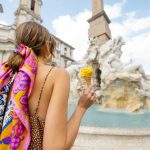Table of Contents
Ever stood in front of a centuries-old fresco and felt like you were peering into the soul of a civilization? That’s the magic of art in travel. It’s not just about pretty pictures – it’s a secret passage to the heart of cultures around the world.
Why Art Matters When You Travel
Art isn’t just for museums and galleries. It’s alive in the streets, the food, the fashion, and the very fabric of societies we visit. When we engage with art during our travels, we’re not just ticking off items on a bucket list – we’re diving headfirst into the complex, beautiful mess of human expression.
Art as a Universal Language
You might not speak Italian, but standing in front of Michelangelo’s David, you’ll feel something. Art transcends language barriers, connecting us on a visceral level. It’s like a cultural shortcut, giving us instant access to the emotions, values, and stories of a place.
In Japan, the minimalist aesthetics of a zen garden speak volumes about the culture’s appreciation for simplicity and nature. In Mexico, the vibrant colors of street murals shout tales of revolution and resilience. These visual cues tell us more about a place than any guidebook ever could.
Getting Your Hands Dirty: Participatory Art Experiences
Want to really get under the skin of a culture? Roll up your sleeves and make some art yourself. Many destinations offer hands-on workshops that let you try traditional art forms:
- Pottery in Greece: Shape clay on a wheel in the land that gave us some of the world’s most iconic ceramic art. As you struggle to center your pot, you’ll gain a new appreciation for those ancient amphoras in the museum.
- Woodblock Printing in Japan: Carve your own design and print it using traditional techniques. The patience and precision required will give you insights into Japanese cultural values.
- Weaving in Peru: Try your hand at Andean weaving techniques passed down through generations. The intricate patterns aren’t just pretty – they’re a living language, telling stories of Incan heritage.
- Sand Painting in the American Southwest: Join Navajo artists in creating temporary masterpieces that embody the concept of impermanence. It’s a spiritual practice as much as an artistic one.
These experiences do more than just teach you a new skill. They connect you with local artisans, support traditional crafts, and give you a tangible way to understand cultural values and history.
Street Art: The Pulse of Modern Culture
Don’t just stick to the official “cultural sites.” Some of the most vibrant art scenes are playing out on city walls around the world. Street art is like a city’s diary, chronicling current events, social issues, and cultural shifts in real-time.
In Berlin, remnants of the Wall are now a sprawling open-air gallery, with murals that speak to themes of freedom and unity. In Melbourne, the ever-changing artworks in its famous laneways reflect the city’s dynamic, creative spirit. And in Valparaíso, Chile, the hillside neighborhoods are a riot of color, with murals that blend social commentary with surreal beauty.
Taking a street art tour or simply wandering and observing can give you incredible insights into the contemporary culture of a place. It’s like reading the community’s collective mind, splashed across building facades.
Art as Time Travel
Museums might seem like the obvious choice for art encounters but think of them as time machines. Each artwork is a window into a specific moment in history, capturing the thoughts, fears, and dreams of people long gone.
In Florence’s Uffizi Gallery, Botticelli’s “Birth of Venus” isn’t just a pretty face – it’s a crash course in Renaissance ideals of beauty and classical revival. The intricate gold backgrounds in Byzantine icons tell us about medieval concepts of the divine. And the distorted figures in Picasso’s “Guernica” scream the horrors of war louder than any history book.
When you visit museums, don’t just shuffle past the “greatest hits.” Take time to read the placards, join a guided tour, or use an audio guide. Understanding the context of artworks can transform your entire perception of a culture and its history.
Food as Art: Culinary Creativity
Who says art has to hang on a wall? Some of the most exciting creative expressions come on a plate. Culinary traditions are a form of living art, passed down through generations and constantly evolving.
In Japan, the presentation of a kaiseki meal is as much about visual harmony as it is about taste. The precise arrangement of colors, textures, and seasonal ingredients on the plate is an edible work of art that embodies deep cultural values.
In Spain, the molecular gastronomy movement has turned restaurants into labs of culinary creativity. Chefs like Ferran Adrià have elevated food to conceptual art, challenging diners to rethink their relationship with what they eat.
Don’t just eat to fuel your sightseeing. Approach each meal as a curated experience, a chance to engage with the artistic spirit of a culture through all your senses.
Performance Art: Culture in Motion
Art isn’t always static. Some of the most powerful cultural experiences come through performance – dance, theater, music, and rituals that bring art to life before your eyes.
Watching a Kathakali performance in Kerala, India, is like seeing paintings come to life. The elaborate makeup, costumes and stylized movements tell epic stories from Hindu mythology. In Bali, a Kecak fire dance at sunset is a mesmerizing display of community coordination and spiritual expression.
Even contemporary performances can offer deep cultural insights. Catching a modern dance show in New York or an avant-garde play in London can give you a pulse on current social issues and artistic trends.
When planning your travels, look beyond the usual tourist shows. Seek out authentic performances, from traditional ceremonies to cutting-edge experimental works. They’re like living, breathing cultural lessons.
Art as Social Commentary
Art has always been a powerful tool for social change, and engaging with it during your travels can give you unparalleled insights into a society’s challenges and aspirations.
In South Africa, the Apartheid Museum uses art installations to create visceral experiences of racial segregation. It’s not just about learning history – it’s about feeling it. In Belfast, the political murals are a stark reminder of “The Troubles” and ongoing social divisions.
But it’s not all heavy subject matter. The whimsical sculptures of Park Güell in Barcelona speak to Gaudí’s vision of harmonious coexistence between humans and nature. The playful street art of Bristol, the birthplace of Banksy, often carries messages of environmental awareness and social justice wrapped in humor.
Keeping an eye out for art with a message can give you a nuanced understanding of a place that goes far beyond surface-level tourism.
Creating Your Own Art: Travel Journaling and Photography
You don’t have to be a professional artist to use creativity as a tool for deeper cultural understanding. Keeping a travel journal or practicing photography can sharpen your observational skills and help you process your experiences.
Sketching a street scene forces you to notice details you might otherwise miss – the unique architectural elements, the way locals interact, and the rhythm of daily life. Writing about your experiences, even if it’s just jotting down observations or overheard conversations, helps you reflect on and internalize what you’re learning.
Photography, when done thoughtfully, can be a powerful way to engage with a place. Challenge yourself to capture not just the iconic sights, but the small moments that speak to the essence of a culture. The way light falls on a centuries-old cobblestone street, the weathered hands of a local craftsman, the juxtaposition of traditional and modern in a rapidly changing city.
These personal creative practices aren’t just souvenirs – they’re tools for deepening your connection to the places you visit.
The Ethics of Artistic Engagement
As we dive into the art worlds of other cultures, it’s crucial to approach them with respect and awareness. Some things to keep in mind:
- Sacred Art: Many cultures have art forms that are deeply tied to spiritual practices. Always ask before photographing or touching sacred objects or participating in rituals.
- Cultural Property: Be aware of the ongoing debates about cultural patrimony. Those ancient artifacts in Western museums? There might be complex stories of acquisition behind them.
- Supporting Local Artists: Whenever possible, buy directly from artists or reputable galleries that ensure fair compensation. Your purchase can help keep traditional art forms alive.
- Responsible Photography: Always ask before taking photos of people, especially in Indigenous communities where there might be beliefs about capturing images.
- Copyright and Social Media: Be mindful of artists’ rights when sharing images of artworks online. Give credit where it’s due.
Art as a Bridge, Not a Barrier
Engaging with art during your travels isn’t about becoming an expert critic or ticking off famous masterpieces. It’s about opening yourself to new perspectives, challenging your assumptions, and finding common ground across cultures.
Art shows us that while human experiences might differ around the world, our capacity for creativity, expression, and beauty is universal. It reminds us that beneath surface-level differences, we share fundamental hopes, fears, and dreams.
So on your next trip, don’t just breeze through the galleries or treat performances as mere entertainment. Slow down. Look closely. Ask questions. Try your hand at creation. Let art be your guide to the soul of a place. You might just find that in understanding others’ expressions, you come to understand yourself a little better too.

I’m Simon St John, an editor who thrives on finding the profound moments in travel. With a background in crafting engaging stories for all generations, I delve into both grand adventures and simple discoveries. Through Tripnosis.me, I aim to showcase how travel can be a powerful catalyst for personal growth and deeper connections. My goal is to present fresh narratives that inspire and redefine your travel experience.




